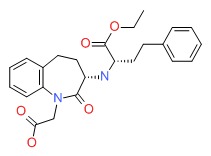NCBI Bookshelf. A service of the National Library of Medicine, National Institutes of Health.
LiverTox: Clinical and Research Information on Drug-Induced Liver Injury [Internet]. Bethesda (MD): National Institute of Diabetes and Digestive and Kidney Diseases; 2012-.

LiverTox: Clinical and Research Information on Drug-Induced Liver Injury [Internet].
Show detailsOVERVIEW
Introduction
Benazepril is an angiotensin-converting enzyme (ACE) inhibitor widely used in the therapy of hypertension. Benazepril is associated with a low rate of transient serum aminotransferase elevations and has been linked to rare instances of acute liver injury.
Background
Benazepril (ben az' e pril) is an ACE inhibitor which is widely used in the therapy of hypertension. Like other ACE inhibitors, benazepril inhibits the conversion of angiotensin I, a relatively inactive molecule, to angiotensin II which is the major mediator of vasoconstriction and volume expansion induced by the renin-angiotensin system. Other host enzymes besides that which converts angiotensin I to II may be inhibited as well, which may account for some of the side effects of the ACE inhibitors. Benazepril was approved for use in the United States in 1991 and current indications are for therapy of hypertension, either alone or in combination with other agents. Benazepril is available in 5, 10, 20 and 40 mg tablets in generic forms and under the trade name Lotensin. The typical dose in adults is 10 mg once daily initially, with gradual adjustment based upon blood pressure response and tolerance. The maximum daily dose is 40 mg in one or two divided doses administered long term. Benazepril is also available in fixed combinations with hydrochlorothiazide (Lotensin HCT and others) and with amlodipine (Lotrel and others). Common side effects include dizziness, fatigue, headache, cough, gastrointestinal upset and skin rash.
Hepatotoxicity
Benazepril, like other ACE inhibitors, has been associated with a low rate of serum aminotransferase elevations (<2%) that, in controlled trials, was no higher than with placebo therapy. These elevations were transient and rarely required dose modification. A few rare instances of clinically apparent acute liver injury have been reported with benazepril therapy. In a single case report of severe liver injury leading to hepatic failure and death, the latency to onset was 14 months which resembles the rare instances of acute hepatocellular injury reported with captopril, enalapril and lisinopril. In contrast, typical ACE inhibitor related liver injury usually arises within 12 weeks of starting therapy and is associated with a cholestatic pattern of injury which can be severe and prolonged. Immunoallergic manifestations (rash, fever, eosinophilia) are infrequent and most patients do not develop autoantibodies.
Likelihood score: D (possible rare cause of clinically apparent liver injury).
Mechanism of Injury
The cause of the minor serum aminotransferase elevations associated with benazepril is not known. The clinically apparent acute liver injury is likely an idiosyncratic reaction to a metabolite. Benazepril is hydrolyzed in the liver to the active metabolite benazeprilat.
Outcome and Management
There have been too few instances of benazepril associated liver injury to provide an overall assessment of its course and outcome. Most instances of acute liver injury reported with ACE inhibitors have been self limited, but there have been rare reports of acute liver failure due to captopril, enalapril, lisinopril and benazepril and several reports of cholestatic hepatitis due to ACE inhibitors including benazepril leading to prolonged jaundice and vanishing bile duct syndrome. Patients with severe benazepril induced acute liver injury should avoid use of other ACE inhibitors, although cross sensitivity to liver injury among the members of this class of agents has not always been shown.
References to the safety and potential hepatotoxicity of benazepril are given in the Overview section on the Angiotensin-Converting Enzyme (ACE) Inhibitors.
Drug Class: Antihypertensive Agents, Angiotensin-Converting Enzyme Inhibitors
PRODUCT INFORMATION
REPRESENTATIVE TRADE NAMES
Benazepril – Generic, Lotensin®
DRUG CLASS
Angiotensin-Converting Enzyme Inhibitors
Product labeling at DailyMed, National Library of Medicine, NIH
CHEMICAL FORMULA AND STRUCTURE
| DRUG | CAS REGISTRY NUMBER | MOLECULAR FORMULA | STRUCTURE |
|---|---|---|---|
| Benazepril | 86541-75-5 | C24-H28-N2-O5 |
 |
- PubChem SubstanceRelated PubChem Substances
- Review Angiotensin-Converting Enzyme Inhibitors.[LiverTox: Clinical and Researc...]Review Angiotensin-Converting Enzyme Inhibitors.. LiverTox: Clinical and Research Information on Drug-Induced Liver Injury. 2012
- Review Enalapril.[LiverTox: Clinical and Researc...]Review Enalapril.. LiverTox: Clinical and Research Information on Drug-Induced Liver Injury. 2012
- Review Lisinopril.[LiverTox: Clinical and Researc...]Review Lisinopril.. LiverTox: Clinical and Research Information on Drug-Induced Liver Injury. 2012
- Effect of benazepril and pimobendan on serum angiotensin-converting enzyme activity in dogs.[J Vet Pharmacol Ther. 2018]Effect of benazepril and pimobendan on serum angiotensin-converting enzyme activity in dogs.King JN, Christinaz C, Strehlau G, Hornfeld J. J Vet Pharmacol Ther. 2018 Jun; 41(3):485-489. Epub 2018 Feb 2.
- Review Fosinopril.[LiverTox: Clinical and Researc...]Review Fosinopril.. LiverTox: Clinical and Research Information on Drug-Induced Liver Injury. 2012
- Benazepril - LiverToxBenazepril - LiverTox
Your browsing activity is empty.
Activity recording is turned off.
See more...